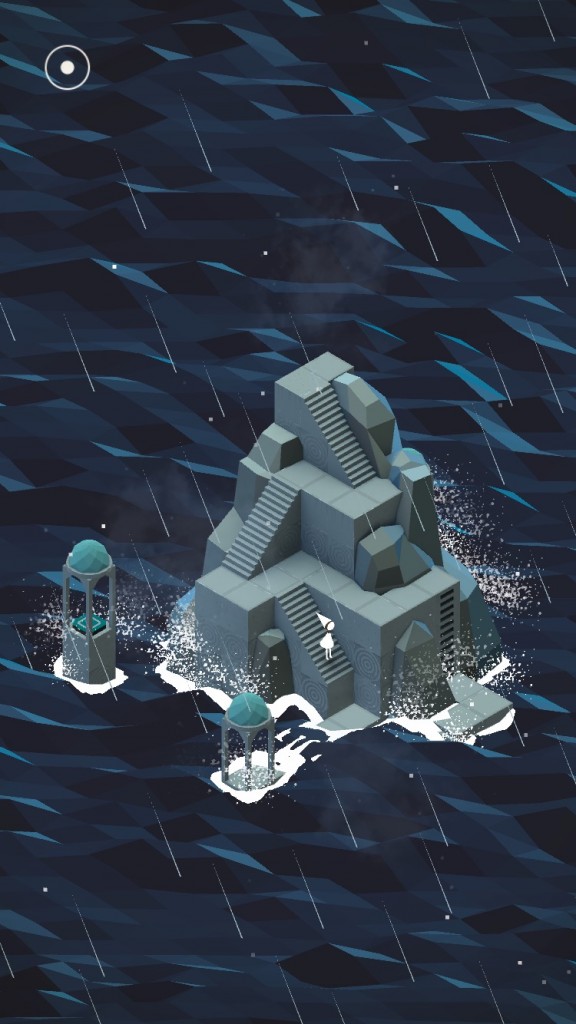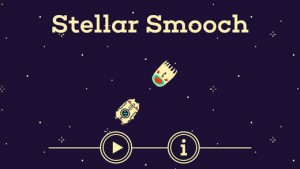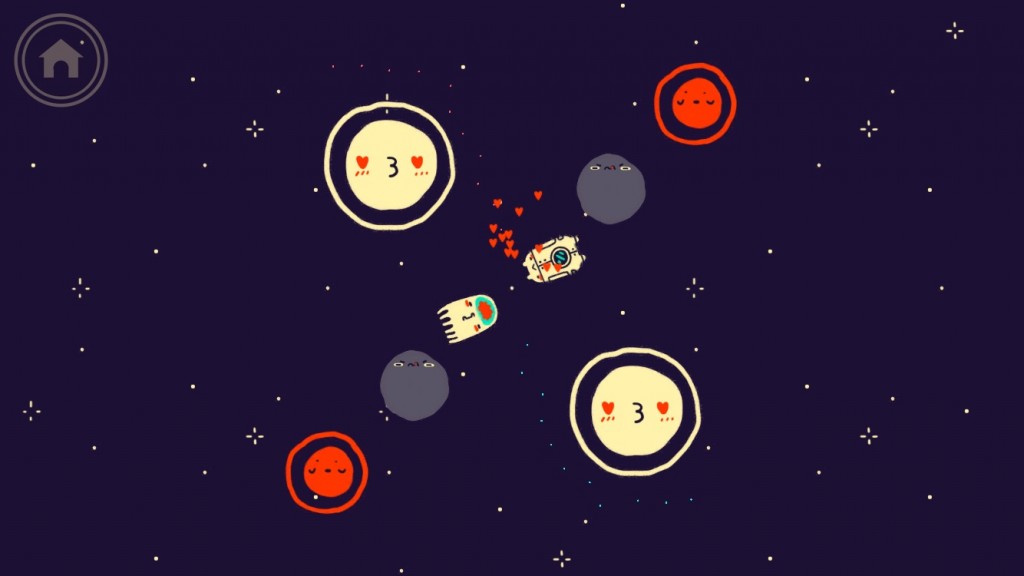Think of this pair of reviews as a salute to the indie puzzle game, on two different scales. One is a student game, entered by its two-person team in the 2015 Independent Games Festival; the other is a well-designed endeavor by the games division of a popular creative firm, named Apple’s iPad Game of the Year in 2014. Both illustrate a growing trend in indie games development: interactive experiences that are simple, easily accessible, and executed with charm.
Both start with minimal instructions. Monument Valley begins on a simple screen, and the words “Tap the path to move Ida” fade slowly into place. Stellar Smooch depicts a cartoon alien and a robot, orbiting two objects in space, saying “Tap to release & make us smooch.” Although both games introduce more complex mechanics, these are their only instructions throughout — the player is compelled to test her surroundings by interacting with the only objects on a screen. Both are narratives of strange journeys, with satisfying puzzle-solving along the way.
We’re rolling off of a rough year for games, games journalism, and games commentary: the community as a whole was consumed with (and arguably cannibalized by) an intense dialogue about what games should be and who should create them. Monument Valley and Stellar Smooch are two mobile games that show a reversal of the never-ending grind and hyperviolence of many triple A titles. Games can be short and meaningful. Games can be challenging and lovely.
Monument Valley
Developer: Ustwo
Platform: iOS, Android
Monument Valley was developed by a studio of eight people, and to see its behind-the-scenes video, a labor of love for all of them. The player guides Ida on a journey to deliver geometric shapes through ten levels (with an additional eight in the Forgotten Realms DLC), all of which have M.C. Escher-esque topography. Levels can be manipulated with sliders, rotating wheels, and buttons, and the shifting geometry of the maps reflect the narrative’s elusive storyline.
The puzzles are never frustrating or punitive, and the game’s original entry can be completed easily in less than an hour. The narrative synergizes well with game’s ambient music and beautiful environment to create an unstressful experience. However, the story is a opaque, and adds to the general atmosphere of the game rather than giving the player a clear idea of what they were playing for — these aren’t purpose-driven puzzles, per se, but an exploration of mood and level design.

In a game with little fat to speak of, there’s only one additional feature: the ability to take and export a screenshot of your particular point of view. There are none of the trappings of a puzzle game in the legacy of Portal or even Lemmings — no baked-in efficiency challenges or ticking clocks. There is no incentive to replay any parts of the game. Monument Valley is a one-shot effort, and I think it benefits from that minimalism; the game speaks to elegant design principle rather than “game value,” a concept that causes developers to bloat a game’s contents to justify a price point.
Stellar Smooch
Developer: Alec Thomson and Jenny Jiao Hsia
Platform: iOS
Stellar Smooch is a student project, and free-to-play for anyone with iOS. Tap the screen to launch a robot and an alien into space, where they can be caught in the gravitational orbit of other stellar objects and relaunched, or sent spiraling off the screen, out of each others’ reach. The goal is to unite the two in a cute smooch, and levels are introduced with lines of a rhyming poem about loneliness and elastic collisions in an empty void.

One playthrough takes fifteen minutes at most, but the physics-based puzzles are very free-form; as long as the alien and robot touch, the game registers a victory on your behalf. Like Monument Valley, there is only one operative instruction in the game. Other stellar objects can change the way your little characters are flung about, but no explanation is given or needed for these slight mechanical shifts. You learn the game by playing it, and then the experience is over, in an eruption of tiny hearts, your only prize a new line of the poem.

None of the levels are hard, really. When I got stuck, it was never because of a confusing or elusive solution, but because I tapped at the wrong time. The cutesy, 8-bit music, the rewarding chimes, and the simple levels make for a happy experience every time I could crash the robot and alien headlong into each other.
“Experience” is a word I’ve used several times in this review, and it speaks to my point about what a game should be. Monument Valley and Stellar Smooch are both deeply interactive, and force the player to think metaphorically: this tap twists the level into a new shape, this tap launches a robot into a pixel void. Both have quiet narratives and unchallenging goals. And yet, I would never describe Borderlands (a franchise I love) as an “experience,” when the game’s main directive is: shoot through set pieces, then advance your character so you can shoot through harder set pieces more effectively.
These two games aren’t dependent on skill or natural-feeling control schemes. The only requirement is that a player interact with an interface. The journey itself is the goal.
I hope to see more like them, and considering the strength of creative indie voices in the past year, I know 2015 will have more game experiences to offer.




Monument Valley is gorgeous and I need to play it right now.
I’ll be honest: Monument Valley was on my radar during its development, but it returned with a vengeance after being featured on Apartment Therapy for great design.
SO CUTE